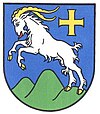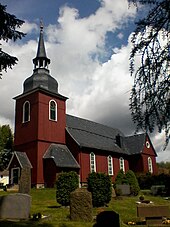Hohegeiß
|
Hohegeiß
City of Braunlage
|
||
|---|---|---|
| Coordinates: 51 ° 39 ′ 50 ″ N , 10 ° 40 ′ 8 ″ E | ||
| Height : | 623 (570-642) m above sea level NHN | |
| Residents : | 909 (December 31, 2018) | |
| Incorporation : | July 1, 1972 | |
| Postal code : | 38700 | |
| Area code : | 05583 | |
|
Location of Hohegeiß in Lower Saxony |
||
|
Hohegeiß around 1900
|
||
Hohegeiß is a resort in the Harz Mountains and a district of Braunlage in the Goslar district in Lower Saxony . The village has about 900 inhabitants.
Geographical location
The mountain village Hohegeiß is located in the Harz Nature Park . It is located between Sorge in the north-north-east and Benneckenstein in the east (both in Saxony-Anhalt ), Rothesütte in the south-east ( Thuringia ), Zorge in the south and Braunlage in the north-north-west (both in Lower Saxony). By about 570 to 642 m above sea level. NN located village leads in the section between Braunlage and Rothesütte the federal highway 4 crossing the Harz . The state border with Saxony-Anhalt (formerly the inner-German border ) leads past the northeastern edge of the village; the border triangle of Lower Saxony, Saxony-Anhalt and Thuringia , where the three-country stone is located, is located about 3.3 km southeast of the village . The Thick Firs natural monument spreads out near the village .
history
The place name first appears in 1268 as Hogeyz ; however not yet as a settlement, but as a forest area. In 1444 a chapel was built here (consecrated on September 8th), around which a settlement had formed by 1528, which in 1573 was first referred to as "Dorf Hohegeist".
From 1701 to 1704 the Protestant church "Zur Himmelspforte" was built and consecrated on December 9, 1704.
From 1720 mines were set up in the valleys around Hohegeiß, which were in operation until 1770.
Hohegeiß was first accessible by public transport in 1842, when the Braunschweig-Blankenburg postal route supplied some Upper Harz locations and also had stagecoaches run from Blankenburg via Hohegeiß to Walkenried. In this year the road to Braunlage (today's Bundesstraße 4 ) and the road to Zorge (today's Landesstraße 602) were completed. Efforts to connect the railroad were unsuccessful, however, the Harzquerbahn was not routed via Hohegeiß, nor was the planned extension of the Ellrich – Zorge railway to Hohegeiß implemented.
In 1911 the place got a central drinking water supply, in 1920 a power supply via its own company.
From 1921 there was bus service to Braunlage and Benneckenstein , later also to Walkenried and Bad Sachsa .
From 1943 during the Second World War , Hohegeiß experienced population growth. From Braunschweig and its surroundings, threatened by Allied bombings, children were evacuated with a selection of teachers and carers as part of the expanded Kinderland deportation. Small hotels and private pensions took them in with rationed supplies. In order to avoid the imponderables of the Soviet military approaching in 1945, the children were brought back to their families in the partly bombed-out Braunschweig by train. Numerous refugees also arrived, so that the population temporarily rose to over 2,200.
On August 1, 1963, 23-year-old Helmut Kleinert from Quedlinburg tried to leave the GDR together with his wife Marlit near the northern exit of the town , and was killed by gunfire by the GDR border troops . His wife was arrested before crossing the border. To commemorate Kleinert's violent death, a wooden cross was first set up on the western side of the border, which was replaced by a memorial stone in 1971.
In 1968 a spa park was built and in 1971 the Catholic Church "Heilig Geist" (consecrated on July 31; 2008 desecrated and sold).
On July 1, 1972, the municipality of Hohegeiß was incorporated into the city of Braunlage.
In 1978, Hohegeiß was officially recognized as a "climatic health resort" after the village had been unofficially called it that way since 1960. As of January 1, 2011, the recognition as a health resort was not extended, since then Hohegeiß has had the tourist status of a resort .
The opening of the inner-German border in 1989 was experienced intensely in Hohegeiß, as the border was not far from the center of the village and represented the eastern edge of the village; several private properties ended at her. From November 12th, the federal highway 4 to Rothesütte could be used by the hour, from November 18th the Benneckensteiner Strasse, initially only for pedestrians.
politics
City Councilor and Mayor
At the municipal level, being incorporated Hohegeiß is the Council represented the city Braunlage.
Mayor
The mayor of Hohegeiß is Robert Hansmann (SPD).
coat of arms
The design of the coat of arms of Hohegeiß comes from the author and painter Karl Helbing from Walkenried. Drawn it has in Isernhagen born and later in Hannover living heraldry and crest painter Gustav nations , which includes the coat of arms of Großburgwedel , Melle village , Wunstorf and many other towns in the region Hannover has designed. The approval of the coat of arms was granted on May 12, 1953 by the Lower Saxony Minister of the Interior .
| Blazon : “In blue, a silver goat reinforced with gold ,jumpingover a green mountain of three ; a golden cross of paws hoversin the upper rear corner of the sign . " | |
| Explanation of the coat of arms: The talking coat of arms points in folk etymological interpretation to the Braunlager district of Hohegeiß, which was incorporated on July 1, 1972. The coat of arms shows a "high goat" jumping over the Harz. The paw cross pictured symbolizes a stone cross, which is located near the original chapel. |
Religions
In Hohegeiß there is the Evangelical Lutheran church "Zur Himmelspforte" from the 18th century (Kirchstrasse 7), belonging to the provost of Bad Harzburg .
In 1971 the catholic church " Heilig Geist " was built, it belonged to the parish "Heilige Familie" in Braunlage and was the highest church of the diocese Hildesheim . In 2008 the church was profaned and sold, today it is used as a "Kyriakon" by the neighboring "Hogeyz" hostel. The nearest Catholic church is now 10 km away in Walkenried .
Regular events
- The place is one of the eight places in which the tradition of the finch maneuver, which has been recognized as an intangible world cultural heritage since 2014, is still cultivated in the Harz Mountains .
Personalities
Sons and daughters of the place
- Karl Uhde (1813–1885), surgeon
- Hermann Grote (1885–1971), composer and teacher
Personalities who lived or worked on site
- Fred Denger (1920–1983), writer, died in Hohegeiß and is buried there
- Karlheinz Schreiber (* 1934), arms dealer, grew up in Hohegeiß
literature
- Friedemann Schwarz: Hohegeiß: Chronicle of a Harz village . Braunlage 2004.
Web links
Individual evidence
- ^ The city of Braunlage in numbers. In: Website of the city of Braunlage. December 31, 2018, accessed March 16, 2019 .
- ↑ Lower Saxony NAVIGATOR
- ^ Federal Statistical Office (ed.): Historical municipality directory for the Federal Republic of Germany. Name, border and key number changes in municipalities, counties and administrative districts from May 27, 1970 to December 31, 1982 . W. Kohlhammer, Stuttgart / Mainz 1983, ISBN 3-17-003263-1 , p. 266 .
- ↑ Small inquiry from Dieter Möhrmann (SPD) and answer from the state government. (PDF; 100 KB) In: Lower Saxony Ministry of Economics, Labor and Transport. January 21, 2011, accessed December 16, 2017 .
- ↑ Friedemann Schwarz , the long-time village teacher and local chronicle, used to say on guided tours: "If I spit over our fence at the back, the spit is in the GDR."
- ^ City council and mayor of the city of Braunlage. In: Website of the city of Braunlage. November 10, 2016, accessed December 16, 2017 .
- ↑ Karl Helbing's coats of arms. In: Wikimedia Commons. Retrieved November 19, 2017.
- ↑ District of Hanover (ed.): Wappenbuch district of Hanover . Self-published, Hanover 1985.
- ^ A b Arnold Rabbow: Braunschweigisches Wappenbuch . The coats of arms of the communities and districts in the urban and rural districts of Braunschweig, Gandersheim, Gifhorn, Goslar, Helmstedt, Peine, Salzgitter, Wolfenbüttel and Wolfsburg. Ed .: Braunschweiger Zeitung, Salzgitter Zeitung and Wolfsburger Nachrichten. Eckensberger & Co Verlag, Braunschweig 1977, DNB 780686667 , p. 50 .









